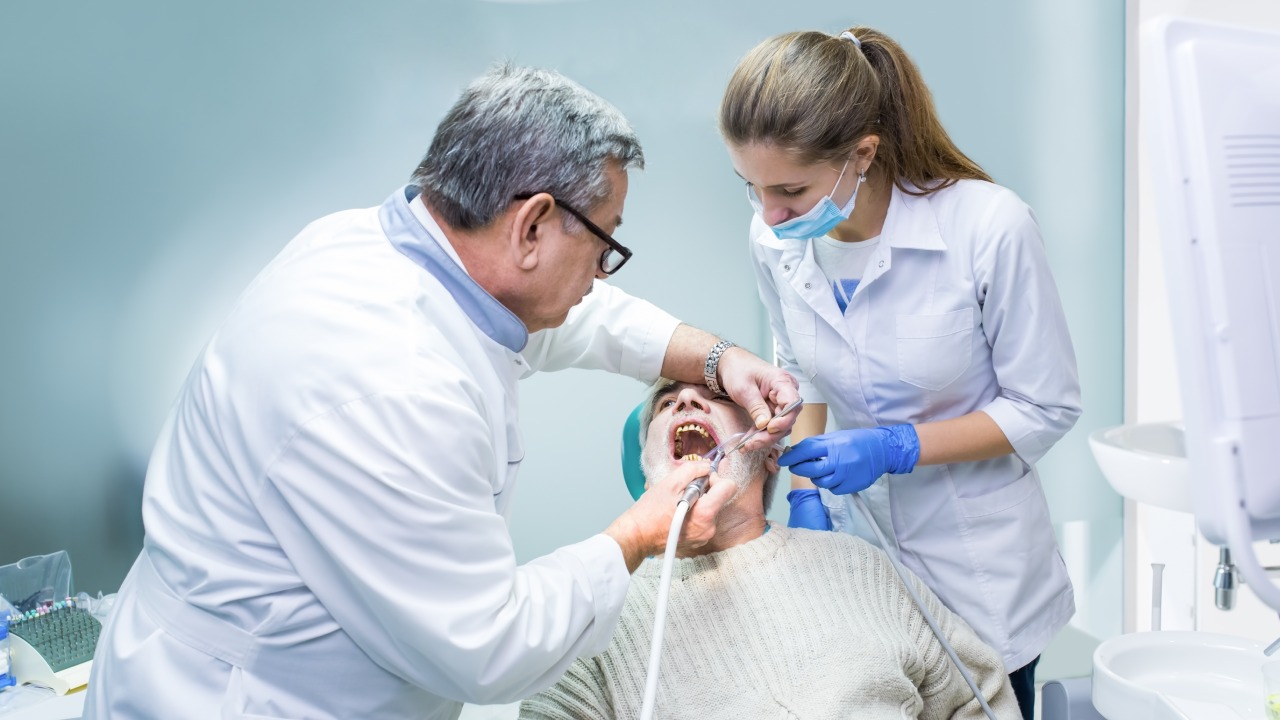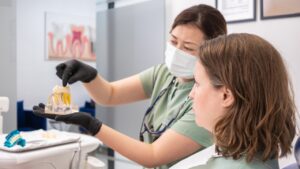Recognizing Dental Emergencies
Signs of Immediate Attention
It’s crucial for everyone to be able to recognize signs indicating the need for emergency dental care. This can prevent long-term damage and ensure prompt treatment. Here are some signs you need emergency dental care right away:
- Bleeding that won’t stop: Persistent bleeding, especially following an injury, signals the need for immediate attention.
- Severe pain that doesn’t improve with medication: Intense discomfort that doesn’t respond to typical pain relief measures should be evaluated by an emergency dentist.
- Broken or knocked-out tooth: A knocked-out tooth or severely broken tooth requires urgent care for the best chance of saving the tooth (Cleveland Clinic Health Essentials).
- Facial swelling or injury: Swelling can point to an infection or trauma that needs quick intervention and broken facial bones necessitate immediate medical assistance (Cleveland Clinic Health Essentials).
| Sign of Emergency | Action Required |
|---|---|
| Persistent bleeding | Seek immediate dental care |
| Severe, persistent pain | Contact an emergency dentist |
| Broken/knocked-out tooth | See a dentist immediately |
| Facial swelling/injury | Immediate evaluation needed |
Emergency Situations to Consider
Certain dental emergencies may require immediate dental treatment. Recognizing these situations and understanding when to act can prevent complications.
- Severe Toothache: A toothache that is unbearable is often a sign of an underlying issue that needs to be addressed quickly. Severe pain could indicate an infection or significant decay.
- Badly Cracked Tooth: A crack can expose the nerves and lead to infection or significant pain. Prompt care ensures that the tooth can be repaired or treated to avoid further damage.
- Knocked-out Tooth: For a knocked-out tooth, time is of the essence. The tooth should be reinserted into its socket within one hour for the best chance of saving it (Cleveland Clinic Health Essentials). Place the tooth in milk or a specialized solution if reimplantation is not immediately possible.
- Partially Dislodged Tooth (Extruded Tooth): A tooth that has been partially dislodged requires urgent intervention to reposition and secure it.
- Dental Abscess: An abscess, which is an infection at the root of a tooth or between the gum and a tooth, can lead to severe complications if left untreated. Symptoms might include significant swelling, fever, and trouble swallowing or breathing (Mayo Clinic). Emergency dental care is crucial for managing the infection and preventing its spread.
For more details on handling specific dental scenarios, visit our articles on how to handle a broken tooth before your dental visit and emergency tooth infections: symptoms and treatment options.
Understanding these signs and situations enables us to respond effectively and seek timely dental care. For other emergency situations, see common dental emergencies we treat same-day.
Dealing with Tooth Trauma
Understanding how to handle sudden dental injuries is essential for preserving your oral health and well-being. Here are some steps for addressing the most common dental emergencies.
Handling a Knocked-Out Tooth
- Immediate Action: Replanting a knocked-out tooth within 30 minutes can potentially save it. Proper emergency action is critical. (American Association of Endodontists)
- Handling the Tooth: Hold the tooth by the crown (chewing surface), not the root. Avoid touching the root to increase the chances of successful replantation.
- Cleaning the Tooth: Rinse the tooth with water if dirty. Do not use soap or scrub the tooth. Avoid drying it with a tissue or cloth.
- Repositioning the Tooth: If possible, reinsert the tooth into its socket immediately. Hold it in place with your fingers or by gently biting down.
- Keeping the Tooth Moist: If you can’t reinsert the tooth immediately, keep it moist. Store it in your mouth, milk, or an emergency tooth preservation kit. Never use tap water as it can damage the root surface cells.
Visit our detailed guide on what to do if you need same-day emergency dental care for more information.
Managing a Tooth Abscess
- Prompt Treatment: Dental abscesses are serious. They require immediate professional treatment to prevent the spread of infection and tissue damage. (Cleveland Clinic Health Essentials)
- Treatment Options: Abscesses do not heal on their own and may need drainage, a root canal, or extraction. (Cleveland Clinic)
- Potential Spread: An untreated abscess can spread to the jawbone, facial tissues, and even to the heart or brain in severe cases.
- Symptoms: Watch for facial swelling, fever, trouble breathing, and swallowing. These symptoms indicate a severe infection requiring immediate care. (Mayo Clinic)
For more on dealing with an abscess, see our article on emergency tooth infections: symptoms and treatment options.
Addressing Broken Teeth
- Severity: Severe fractures, where a significant part of the tooth is missing, cause intense pain and sometimes bleeding. Immediate dental care is necessary. (SomervilleDentist)
- Minor Fractures: Minor chips do not require emergency intervention but need dental evaluation to prevent future complications.
- Early Treatment: The sooner a broken tooth is treated, the lower the risk of infection and the better the recovery outlook. Particularly for significant fractures, timely intervention is crucial. (SomervilleDentist)
| Type of Tooth Trauma | Immediate Steps |
|---|---|
| Knocked-out Tooth | Reinsert if possible; keep moist |
| Tooth Abscess | Seek immediate treatment; look for infection signs |
| Broken Tooth | Stabilize, avoid chewing on the area, seek quick dental care |
Learn more about how to handle dental injuries in our comprehensive guide on how to handle a broken tooth before your dental visit.
For individuals facing urgent dental situations, our clinic provides expert, immediate attention tailored to your needs. Learn about the benefits of choosing a local emergency dental clinic to see why our services are trusted and reliable.
Urgent Care Advice
Understanding when and how to seek urgent care for severe tooth pain is crucial. Here’s a detailed look at the options available and the role of urgent care facilities in managing dental emergencies.
Options for Severe Tooth Pain
Severe tooth pain can disrupt daily life and require immediate attention. Our goal is to alleviate pain effectively and ensure appropriate follow-up care. Here are common options for managing severe tooth pain:
Emergency Dental Services
At Baltimore Emergency Dental, we offer comprehensive emergency dental services designed to address acute pain efficiently. Our team is equipped to handle various dental emergencies, from cracked teeth to severe infections. Immediate consultation with our dentists ensures accurate diagnosis and treatment, providing you relief and peace of mind.
| Treatment Option | Description | Average Relief Time |
|---|---|---|
| Emergency Dental Services | Immediate professional care for diagnosing and treating tooth pain | 1-3 hours |
| Urgent Care Facilities | Alternative when a dentist is not immediately available; similar treatments to ER | 2-4 hours |
| Home Remedies | Temporary pain relief using over-the-counter medication and cold compresses | Variable |
Over-the-Counter Relief
For immediate but temporary relief, over-the-counter pain relievers can be utilized. Non-prescription medications such as ibuprofen or acetaminophen can help manage pain until professional dental care is available. It’s essential to follow the dosing instructions and consider using a cold compress to reduce swelling if necessary (Cleveland Clinic Health Essentials).
For more comprehensive advice on managing pain until you can see a dentist, explore our guide on managing dental pain until you can see a dentist.
Role of Urgent Care Facilities
Urgent care facilities play a significant role when immediate dental care is needed, and a dental clinic is not accessible. Here’s how they can help:
Treatment Similar to Emergency Rooms
Urgent care centers can provide treatments comparable to those in emergency rooms for tooth pain. They can administer pain medication, perform initial assessments, and offer temporary solutions to alleviate discomfort (University of Utah Health). While this is beneficial for immediate relief, follow-up consultations with a dentist are crucial for comprehensive care.
| Facility Type | Services Provided | Focus |
|---|---|---|
| Emergency Dental Clinics | Full-service emergency care tailored to dental needs | Comprehensive dental health |
| Urgent Care Centers | Temporary relief, initial assessments, pain management | General health services |
Follow-Up with Dental Professionals
While urgent care facilities can be a practical short-term solution, it’s essential to visit a dental professional for a thorough evaluation and long-term treatment plan. Proper follow-up ensures no underlying issues are overlooked and that appropriate action is taken to restore dental health.
For insights on whether to visit an emergency dentist or the ER, refer to our detailed article on when to go to an emergency dentist vs. the ER.
Our team at Baltimore Emergency Dental is dedicated to providing timely and effective emergency dental care. By understanding your options and the role of urgent care facilities, you can make informed decisions to ensure your dental health is prioritized. For immediate attention or further guidance on dental emergencies, reach out to us or read more about common dental emergencies we treat same-day.
Tooth Abscess & Emergency Care
Tooth abscesses are a serious dental emergency requiring prompt medical attention. Recognizing the signs and understanding the importance of immediate treatment can prevent severe complications.
Understanding Tooth Abscess
A tooth abscess is a pocket of pus caused by a bacterial infection within the tooth or gums. This condition arises when bacteria enter the tooth through an untreated dental cavity, a crack, or previous dental work (Cleveland Clinic). The infection and inflammation can spread, leading to more severe health issues if left untreated.
Common Causes of Tooth Abscess
- Untreated tooth decay
- Cracked or damaged tooth
- Complications from previous dental work
In advanced cases, the infection can spread beyond the immediate area to the jawbone, soft tissues of the face and neck, and even critical areas like the heart and brain (Cleveland Clinic).
Importance of Prompt Treatment
Prompt treatment of a tooth abscess is crucial. The primary goals are to eliminate the infection and prevent further complications. Our expert team at Baltimore Emergency Dental is dedicated to providing comprehensive and immediate care solutions.
Potential Risks of Unattended Abscess
- Spread of Infection: The infection can spread to the jaw, throat, neck, sinuses, or other areas of the body.
- Sepsis: A severe, life-threatening infection that can spread throughout the body.
- Life-threatening Complications: Conditions such as bacterial meningitis or endocarditis can develop if the abscess remains untreated (Mayo Clinic).
Treatment Options
- Drainage of the Abscess: Draining helps to remove the pus and reduce the inflammation.
- Root Canal Treatment: This procedure treats the infection while preserving the tooth.
- Tooth Extraction: In severe cases, the tooth may need to be removed to thwart the infection.
| Treatment Option | Procedure Description |
|---|---|
| Drainage of Abscess | Draining the pus to reduce infection |
| Root Canal | Removing infected pulp and sealing the tooth |
| Tooth Extraction | Removing the infected tooth entirely |
Understanding the signs you need emergency dental care right away can save not only your teeth but also your overall health. For guidance on handling such emergencies, visit our page on what to do if you need same-day emergency dental care.
Internal Links
- what to do if you need same-day emergency dental care
- how emergency dentists treat tooth pain fast
- how to handle a broken tooth before your dental visit
- emergency tooth infections: symptoms and treatment options
- when to go to an emergency dentist vs. the er
- common dental emergencies we treat same-day
- managing dental pain until you can see a dentist
- same-day emergency care for kids and teens
- the benefits of choosing a local emergency dental clinic
Strategies for Tooth Preservation
When faced with a dental emergency, especially a knocked-out tooth, employing proper tooth preservation techniques is crucial. Here, we will discuss effective [tooth preservation techniques] and how to maximize your chances of saving the tooth.
Tooth Preservation Techniques
1. Handle by the Crown: When dealing with a knocked-out tooth, always pick it up by the crown (the chewing surface). Avoid touching the root to prevent damaging the cells necessary for reattachment (American Association of Endodontists).
2. Keep the Tooth Moist: To maintain the viability of a knocked-out tooth, keep it moist at all times. You can place it back in its socket, hold it between your cheek and gums, or store it in milk. Avoid using regular tap water as root surface cells cannot tolerate it for extended periods (American Association of Endodontists).
| Storage Medium | Success Rate |
|---|---|
| Original Socket | Highest |
| Milk | High |
| Mouth (Cheek/Gum) | High |
| Saline Solution | Moderate |
| Tap Water | Low |
3. Reinsert if Possible: If possible, reinsert the tooth into its socket. Gently push it with your fingers or position it above the socket and close your mouth slowly to hold it in place (American Association of Endodontists).
4. Use Emergency Tooth Preservation Kits: Consider purchasing tooth preservation kits, which are readily available over-the-counter. These kits contain solutions that help maintain the viability of the tooth until you can reach one of our emergency dental clinics.
Maximizing Tooth-saving Chances
1. Act Quickly: Time is a critical factor in saving a knocked-out tooth. The chances of successfully replanting the tooth are highest if you see a dentist within one hour of the injury. If immediate reinsertion is not possible, use milk or a specialized solution for storage (Cleveland Clinic).
2. Seek Professional Help Fast: Contact your dentist or visit an emergency dental clinic as quickly as possible. Immediate professional care significantly improves the likelihood of saving the tooth.
3. Avoid DIY Measures: Do not use household products like toothpaste or disinfectants on the knocked-out tooth. Always follow professional advice to avoid further damage.
By following these strategies, you can maximize the chances of saving a knocked-out tooth and preserving your dental health. For more detailed advice on handling dental emergencies, please refer to our pages on what to do if you need same-day emergency dental care, how to handle a broken tooth before your dental visit, and common dental emergencies we treat same-day.
Additional Dental Emergency Situations
At Baltimore Emergency Dental, we understand the critical nature of various dental emergencies. Recognizing the signs you need emergency dental care right away can make all the difference in preserving your oral health. Here, we address two common emergency scenarios: treating soft tissue injuries and managing dental restorations.
Treating Soft Tissue Injuries
Soft tissue injuries in the mouth can be alarming and require prompt attention. These injuries might include cuts, tears, or punctures to the lips, cheeks, gums, or tongue. If you experience severe soft tissue injuries, there are steps you can take to manage the situation until you can reach us for professional care.
- Control Bleeding: Use a piece of clean gauze or a cloth to apply gentle pressure to the affected area to control bleeding.
- Pain Relief: To alleviate pain and reduce swelling, apply a cold compress to the outside of the mouth or cheek near the injury. Over-the-counter pain relievers such as acetaminophen or ibuprofen can also help control discomfort.
- Seek Prompt Attention: It’s important to get professional evaluation and treatment as soon as possible. Call our office immediately or visit our clinic to ensure proper care and to prevent potential complications.
By following these steps, you can effectively manage the situation until you receive professional care. For more guidance, explore our resources on same-day emergency care for kids and teens.
Managing Dental Restorations
Dental restorations such as crowns, bridges, and fillings can sometimes fail unexpectedly. If you find yourself dealing with a loose or lost restoration, it’s important to take appropriate action to avoid further damage to your teeth and gums.
- Lost Filling or Crown: If a filling or crown falls out, try to keep the lost piece safe and contact us immediately. Avoid eating or chewing on the affected side of your mouth. You can use dental cement (available at most drugstores) to temporarily reattach the crown.
- Broken Dental Appliance: For broken dentures or other dental appliances, avoid wearing them to prevent injury to your gums. Contact our office to schedule an emergency repair or replacement.
- Temporary Measures: Using dental wax can help protect the exposed areas of your teeth and gums until you can see a dentist. This can provide some comfort and prevent sharp edges from causing further injury.
Timely and effective action can save your dental restorations and prevent discomfort. For more detailed instructions, check our page on how to handle a broken tooth before your dental visit.
These strategies can help you manage common dental emergencies until you’re able to get professional care. For a comprehensive understanding of various emergency situations, see common dental emergencies we treat same-day.
By quickly recognizing and addressing these dental emergencies, we can help you preserve your oral health and avoid complications. If you or someone you know is experiencing a dental emergency, please contact Baltimore Emergency Dental for prompt and expert care.








